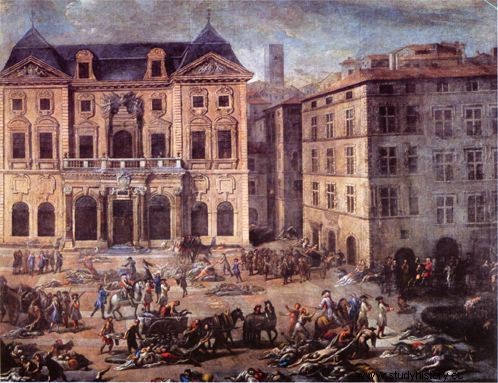 The Great Plague of 1720 at La Tourette, in Marseille, work of the painter Michel Serres (1658-1733)
The Great Plague of 1720 at La Tourette, in Marseille, work of the painter Michel Serres (1658-1733) BACILLI. It is a myth that falls. And the results of this startling study will force historians to take another look at all the major plague episodes that arose in Europe between the 14th and 18th centuries! A team from the Max-Planck Institute (MPI) in Germany has succeeded in reconstructing the genome of the bacillus Yersinia pestis , at the origin of the plague epidemic which ravaged Marseille between 1720 and 1722. This work proves that the terrifying pathogen did not come from Asia, as it was believed until then, but descended directly from the person responsible for the first pandemic that ravaged Europe in the 14th century, known as the frightening "Black Death". Between 1342 and 1353, it had indeed decimated almost half of the population of Europe! In other words, "the bacillus of this medieval black plague persisted locally for several centuries before suddenly reappearing !”, explains paleopathologist Olivier Dutour, director of the Paul Broca biological anthropology laboratory at the Ecole Pratique des Hautes Etudes in Paris, one of the signatories of the study.
"Rats are not the only culprits"
The analyzes were carried out using pathogenic elements taken from the dental pulp of several individuals who died in the 18th century in Marseille and found in the pits of plague victims. Until then, history established that the origin of the plague epidemic that appeared in the Phocaean city came from Grand-Saint-Antoine, a ship that arrived on May 25, 1720 from the Levant, and whose cargo of cotton fabrics had been contaminated with Yersin's bacillus, via rat fleas. Serious negligence, an unrespected quarantine of passengers and goods had done the rest, allowing the disease to spread through the city like wildfire, leading to the death of 40,000 people out of the 90,000 inhabitants, before winning. all of Provence and cause more than 120,000 victims!

An episode of the bubonic plague epidemic that raged in Marseille between 1720 and 1722, illustrated by the painter Michel Serres (1658-1733). 40,000 inhabitants were killed.
ANTIBIOTICS. However, many questions remain unanswered. Indeed, we still do not know precisely what were the mechanisms that led to the sudden disappearance of the plague in Europe. Nor especially the exhaustive list of animals likely to have constituted its permanent reservoir on the spot! "Because the rats are not the only ones to blame" , adds the paleopathologist. At the start of the 21st century, there are still several thousand cases of plague in the world, the majority of which are located in Africa. Most of the known strains, particularly in the United States and Canada, are direct descendants of the strain that appeared in China at the end of the 19th century, identified in its time by the Franco-Swiss Alexandre Yersin (1863-1943) (read Science and Future N°789 ). Antibiotic-based treatment reduces the mortality rate, except in Madagascar where resistant strains have developed. In France, the last declared cases of plague date back to 1945, in Corsica, the disease having since been totally eradicated in Western Europe. Does it persist elsewhere? In animal populations of the Russian steppes or in Central Asia? The question is asked.
